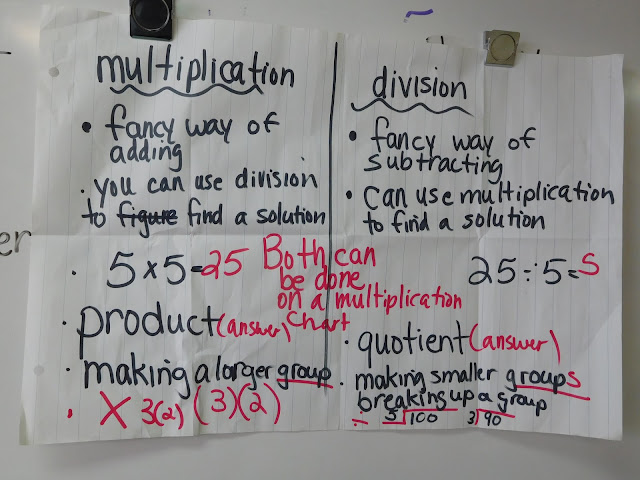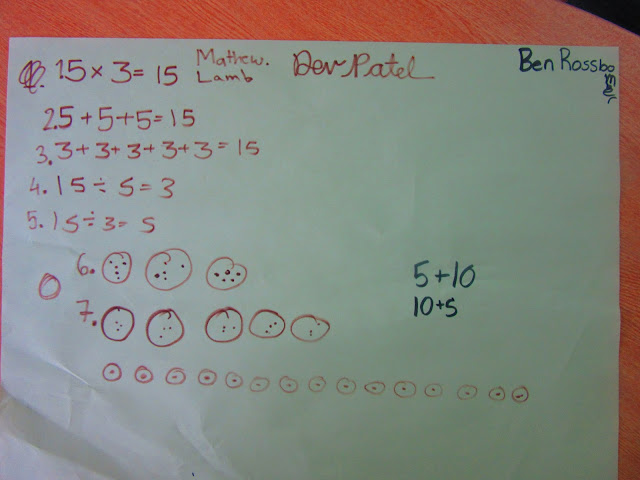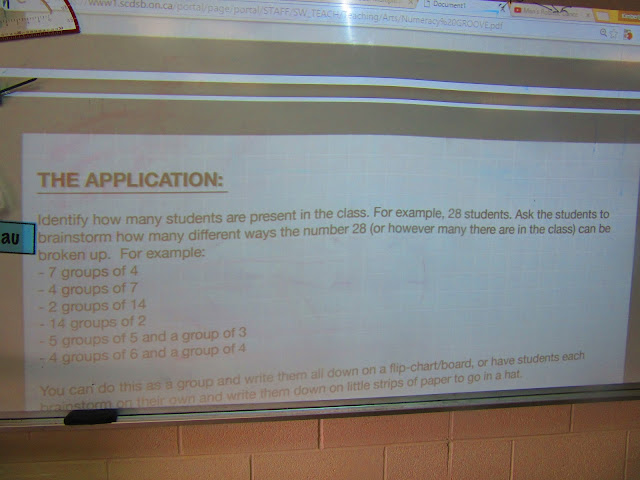Wednesday, April 27, 2016
Tuesday, April 26, 2016
DIVISION!!!
Yesterday, we began investigating division strategies. First we compared what we knew about division to what we know about multiplication. We know that multiplication is the opposite operation of division.
Then we worked on the following Minecraft math problem from Ottawa Bansho:
Most students came up with their own strategies to solve the problem, so were stuck.
We consolidated our learning by sharing the variety of strategies we came up with. Students shared and explained their strategy. We also discussed the importance of LOOKING BACK TO VERIFY THE REASONABLENESS OF SOLUTION by using the opposite operation, or a second strategy to check our answer.

Today we moved on to a messier problem, still using student generated strategies. Students' repertoire of strategies is now greater because they have learned from sharing their ideas. We will see tomorrow how they made out, but from circulating, I can confirm that I am seeing great learning and some very successful strategies.
Then we worked on the following Minecraft math problem from Ottawa Bansho:
Most students came up with their own strategies to solve the problem, so were stuck.
We consolidated our learning by sharing the variety of strategies we came up with. Students shared and explained their strategy. We also discussed the importance of LOOKING BACK TO VERIFY THE REASONABLENESS OF SOLUTION by using the opposite operation, or a second strategy to check our answer.

Today we moved on to a messier problem, still using student generated strategies. Students' repertoire of strategies is now greater because they have learned from sharing their ideas. We will see tomorrow how they made out, but from circulating, I can confirm that I am seeing great learning and some very successful strategies.
Thursday, April 14, 2016
COMPLETE MATH PROBLEM!!! PLEASE COMPLETE
LET'S SEE WHO CAN SPEND THE CLOSEST TO $1OO WITH A 100 BIRDS
Budgie Problem
Complete this
problem in your math notebooks.
A bird collector
wants to buy 100 budgies and wants to spend as close to $100 as possible. Blue budgies cost $10 each, green budgies
cost $3, and yellow budgies cost 50 cents each.
The collector wants to purchase at least one budgie of each colour. How many blue, green and yellow budgies could
he buy?
Wednesday, April 13, 2016
TODAY IN SOCIAL STUDIES: COMPARING THREE ORIGIN THEORIES
FOR STUDENTS THAT WERE AWAY TODAY:
In our studies of the First Nations People of North America, we have studied the Creation Story en Français, students have little skits and created a small media piece to transmit their understanding of the theory, in French.
Today, we visited the following website. FIRST NATIONS PEOPLE First, began a KNEW/NEW sheet. Dividing a line paper in half, on one side we wrote what we already knew about the origins of First Nations. Once we visited the website and listened to the interactive lessons, we filled out the NEW side of the sheet with our new knowledge.
I would show you a few samples of the KNEW/NEW pages, but I just dropped and broke my camera...and now I want to cry. :(
In our studies of the First Nations People of North America, we have studied the Creation Story en Français, students have little skits and created a small media piece to transmit their understanding of the theory, in French.
Today, we visited the following website. FIRST NATIONS PEOPLE First, began a KNEW/NEW sheet. Dividing a line paper in half, on one side we wrote what we already knew about the origins of First Nations. Once we visited the website and listened to the interactive lessons, we filled out the NEW side of the sheet with our new knowledge.
I would show you a few samples of the KNEW/NEW pages, but I just dropped and broke my camera...and now I want to cry. :(
VOCABULAIRE POUR LA THÉORIE DE PONT DE TERRE
Monday, April 11, 2016
MULTIPLICATION: LESSON 1 -AREA MODELS/ARRAYS
HOW MANY DIFFERENT WAYS CAN YOU SHOW 3 X 5?
Students worked in groups to come up with as many different ways as they could collectively think of.
As groups showed us their work, I recorded their ideas. This is what we came up with:
TODAY WE DECIDED TO FOCUS ON AREA MODELS/ARRAYS
We loved this song to help illustrate the strategy and put us in the Grove mood! We sang and groved along.
Then, of course, we did some GROVE MATH!!!
THIS WAS OUR SONG:
Afterwards, we practiced using the area model, on white boards, to help us with multiplication.
A LITTLE INSPIRATION FOR TOMORROW'S GROVE MATH WHEN WE GROUP INTO MORE ARRAYS!
Friday, April 8, 2016
MORE 3-D GEOMETRY - GROVE MATH -VOLUME AND CAPACITY
This week, we incorporated GROVE MATH into our lessons!!! This is especially great for kinesthetic learners, but also to include more physical activity and dance into our cross-curricular activities! These activities have the included bonus of teaching mindfulness (being in the moment). Unfortunately, I was so in the moment myself, that I do not have a video to share with students participating in Grove Math. Our song was Shake it Up.
This Math Grove engages the body, brain, and being.
Students then made human 3-D Figures taking the different faces, edges and vertices into account.
Next, they were given and investigation. Their job was to design packaging for a company's product. Students had to design as many nets as possible to present their proposal to the board of directors. They used the connects to help them investigate all possibilities.
We learned that pyramids, as well as prisms can be represented as a 2-D shape if you unfold it. The pattern, or the "NET" can then be folded to make the 3-D shape. 3-D figures can have more than one possible net.
As an entrance ticket the next day, students were given the connects to make cubes. They were then challenged to find all the possible nets for a cube, being careful to not rotate a net and count it more than once.
VOLUME AND CAPACITY
The next day, we began with a Math Grove excercise to review 3-D figures and their properties. To the music of "Swift Sword".Afterwards, we discussed the similarities and differences between 2-D and 3-D shapes. This lead us into a discussion and investigation of capacity and volume, as well as the relationship between the two measurements. And, of course, we needed to use lots of water to satisfy our curiosity about capacity and the displacement of liquids!!! We found some cool songs to help us remember what we have discovered.
We now know that 1 cm cubed is equal to 1 mL. We know that a 10 cm cubed object, for example, will displace 10 mL of water. We know that volume is the space that an object occupies, and capacity is the amount a container can hold.
Subscribe to:
Comments (Atom)





















































